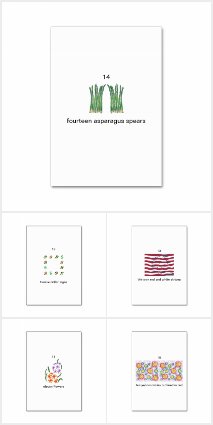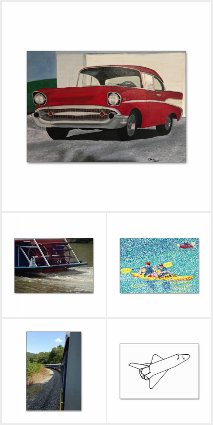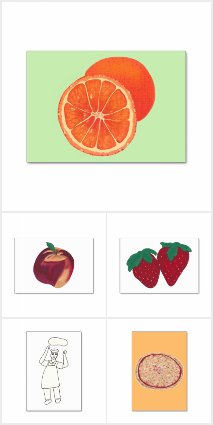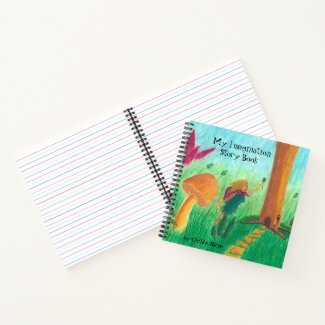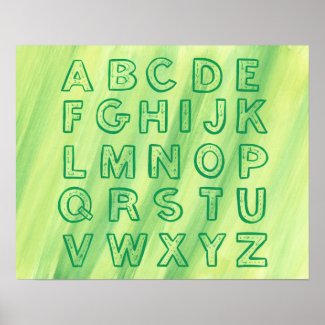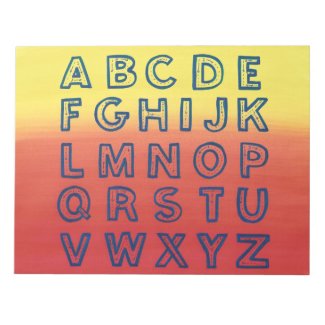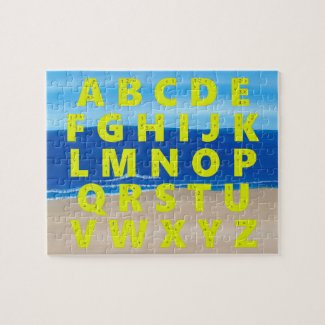Choose from number flashcards for the numbers 1-20. You can choose them as they are, and or customize with your own image(s) and or text if you like.
The front of the card features the word for the number.
The back of the flashcard depicts the number, a picture image to represent the number, and text below the image describing the number and the image.
You can see all the flashcards in the Number Flashcard collection at my CustomFlashCards store on Zazzle:
The flashcards are suitable for a variety of ages, including adult literacy students.
Happy learning and or teaching.
Cheryl Paton
Literacy and Phonics, Phonetic Alphabet Book by Cheryl Paton
Cheryl Paton shares tips about literacy, mainly helping adult reading students. Find other literacy news and tips on my Facebook page. www.facebook.com/LiteracyIdeas/
Labels
- abc video (1)
- alphabet (3)
- creative writing for kids (2)
- crossover letters (1)
- flashcards (2)
- literacy activities (1)
- literacy games (2)
- literacy tips (3)
- phonetic alphabet book (4)
- phonics (11)
- phonics rules (2)
- picture dictionaries (1)
- reading activity (6)
- restroom signs (1)
- sight words (1)
- spelling rules (2)
- teaching syllables (1)
- the phonics guide (2)
Friday, February 2, 2024
Tuesday, November 9, 2021
Reading Flashcards for Adults
Here you will find custom reading flashcards for adults. They are custom because you can actually customize the text that is printed on the back of the cards to make them more specific to your student or students. They are for adults because the images don't have the cutesy child look; they have a more mature look.
Some cards have more sentences than others, others are more basic.
Not all students are on the same level, and you can change the words to fit your needs. When I taught reading to adults, some were very beginners, and some of my students already knew quite a lot of sight words.
I am in the process of creating more categories, so if you have a request for a category that I haven't covered yet, or want additional items in the categories that I've already done, just let me know.
This first category is Transportation.
Another common category that is helpful to adults is Food. This would be really helpful should your student shop in stores that don't show pictures on the can goods.
Visit my Custom Reading Flashcards on my other blog to see all the options:
Another set of words that could be helpful to your students, is to draw the various images and words that are posted on restrooms in your area. In my area, there are not just Men and Women, but gals and guys, mexican words, and more. This can be a very helpful lesson plan to persue to make life easier for your student.
All the best.
Cheryl Paton
Some cards have more sentences than others, others are more basic.
Not all students are on the same level, and you can change the words to fit your needs. When I taught reading to adults, some were very beginners, and some of my students already knew quite a lot of sight words.
I am in the process of creating more categories, so if you have a request for a category that I haven't covered yet, or want additional items in the categories that I've already done, just let me know.
This first category is Transportation.
Another common category that is helpful to adults is Food. This would be really helpful should your student shop in stores that don't show pictures on the can goods.
Visit my Custom Reading Flashcards on my other blog to see all the options:
Another set of words that could be helpful to your students, is to draw the various images and words that are posted on restrooms in your area. In my area, there are not just Men and Women, but gals and guys, mexican words, and more. This can be a very helpful lesson plan to persue to make life easier for your student.
All the best.
Cheryl Paton
Monday, August 16, 2021
Creative Writing for Kids
Check out these fun fairy themed books to encourage creative writing for kids.
These books feature a fun painting of a fairy in a woodsy area with flowers.
The fairy is holding something. Is it a magic wand, a branch, perhaps a gift?
Why is the fairy in the forest? Does the fairy live there, or just visiting?
Why is the mushroom so large? What is it used for?
Who lives behind that little door at the bottom of the tree? Wait, there are stairs that lead up to another door. Is that a second story to the house, or perhaps an apartment since it has it own outside set of stairs?
These questions can be used to help spark your child's creativity. Are there other questions that you can think of?
Young children may write or dictate simple sentences. Each statement can be written on a new page. The picture is there for added inspiration on each page.
An older child can write chapters for a longer story. Multiple sentences can be written on a page and continued on to make a chapter, and even multiple chapters for a longer story.
As you can see, this fun book can provide great opportunities for a variety of creative writing and reading opportunities for a variety of ages. It would make a fun gift for any child.
Fairy Stories: A Creative Story Writing Journal for Kids shows the fairy picture on every page and is purchased on Amazon:
This version, My Imagination Story Book, is spiral bound; the book can lay flat when open. It has more lines for writing on but does not have the fairy picture on each page. You can however select the type of lines you would like printed in this book. My Imagination Story Book can be personalized with the child's name on the cover, and is purchased on Zazzle.
The Little Fairy and Her Imagination is the story that I created using this fun fairy picture! The questions posed above are answered in this fun, imaginative book. Click on the text link to purchase on Amazon:
One of the creative writing books along with a copy of The Little Fairy and Her Imagination makes a wonderful gift set! Children can read the story that I created and also create their own!
Thank you for your support of the arts and creativity.
Cheryl Paton
Saturday, March 21, 2020
Video of How to use The Phonics Guide by Cheryl Paton
This blog explains how to use the book, The Phonics Guide: A Guide to Reading and Spelling Patterns, by Cheryl Paton.
What is The Phonics Guide?
The Phonics Guide is a book that lists common spelling patterns used in the English language, along with information about each individual letter of the alphabet. The chapters are arranged alphabetically for ease of locating the information.
How do I use The Phonics Guide?
If you want to look up information about any letter, you would go to the chapter labeled with that letter. There you will find information about the letter itself, as well as common letter patterns in which the letter is used.
For instance, if you go to the chapter on the letter c, you will find out that C is a consonant and that it represents two main sounds and can also be silent. C is used in the cl blend. Examples of words using the cl blend are shown, and sometimes a pictorial drawing is included to demonstrate the general sound. You can also go to the chapter on L, and see that the letter l is used with a variety of letters to represent various L blends.
Here is a video that I made that explains it a bit more.
If you have any questions or comments, the best place to ask and or comment is on my Literacy Ideas page on Facebook.
The Phonics Guide: A Guide to Reading and Spelling Patterns, is purchased on Amazon, which is where the previous text link will take you.
Blessings to you.
Cheryl Paton
As an Amazon affiliate, Cheryl Paton, earns income from qualifying purchases made through her links.
What is The Phonics Guide?
The Phonics Guide is a book that lists common spelling patterns used in the English language, along with information about each individual letter of the alphabet. The chapters are arranged alphabetically for ease of locating the information.
How do I use The Phonics Guide?
If you want to look up information about any letter, you would go to the chapter labeled with that letter. There you will find information about the letter itself, as well as common letter patterns in which the letter is used.
For instance, if you go to the chapter on the letter c, you will find out that C is a consonant and that it represents two main sounds and can also be silent. C is used in the cl blend. Examples of words using the cl blend are shown, and sometimes a pictorial drawing is included to demonstrate the general sound. You can also go to the chapter on L, and see that the letter l is used with a variety of letters to represent various L blends.
Here is a video that I made that explains it a bit more.
If you have any questions or comments, the best place to ask and or comment is on my Literacy Ideas page on Facebook.
The Phonics Guide: A Guide to Reading and Spelling Patterns, is purchased on Amazon, which is where the previous text link will take you.
Blessings to you.
Cheryl Paton
As an Amazon affiliate, Cheryl Paton, earns income from qualifying purchases made through her links.
Wednesday, July 17, 2019
Alphabet Chart for Adults
Here you will find simple alphabet charts that can be used for adults. You can choose from posters, notepads, and puzzles.
These charts have an artistic background to offer some visual interest. There are direction arrows on the letters to guide your students in the mechanics of writing each letter. Students can follow the arrows on each letter with their finger, and also use the chart for copying the letters onto paper.
This first chart features the upper case letters done with green outlines of the letters on a blended yellow and green background.
I wanted to use something that adults can enjoy looking out while they are learning and practicing how to write the upper case letters. This one is printed on posters.
This design features an ombre sunset design, with blends of yellow, orange, and red. It is shown here on 40-page notepads. Students can trace the letters on the notepad multiple times.
The third design features a beautiful beach scene with a blue ocean. This design is shown on jigsaw puzzles, for some added fun. Sometimes its nice to do some learning in a less focused way. It can be a great reinforcement activity.
Check my CherylsArt store on Zazzle for more alphabet options.
Thank you.
Cheryl Paton
Friday, January 8, 2016
Teaching English Phonics to Adults
I have been a literacy tutor for adults, first as a volunteer, and then I was in private practice, for a total of over twelve years. I have learned more about what various adult students actually want, and what helped them the most.
First, there are many different levels of literacy. Some students may know quite a bit of sight words, others may know some sounding out skills, and some may be total beginners.
Some students may have specific goals in mind. One of my clients planned to hike from one state to another, and only wanted to learn enough about plants to know which ones were safe to eat.
Whatever their skill level, or goal, I found hands on activities to be very helpful. The clients/students need something to help reinforce what they are learning and their goals.
As with any type of learner, whether child or adult, people can have different learning styles. Some may be more visual learners, others more auditory, etc. If you are tutoring your adult student one on one, you can tailor the lessons more to their individual learning style. However, I have found that it is a good idea to offer a variety of activities that can enhance a different type of focus. The different types of focus can help to reinforce and build learning across the board.
Word Search and Crossword Puzzles can be Custom Made for Specific Letter Patterns
Searching for words in a mixed up group of letters can help with both individual letter recognition, and also recognition of words that are out of context. I used to shop around trying to find word search books that were more appropriate for adults. I did find some that were more suitable at a Teacher Resource store.
However, once I found out that I could make my own tailored puzzles to a specific letter pattern, and or specific words, it was so much more helpful and convenient. I could tailor the word searches to each specific student's needs and wants.
However, if you would prefer to purchase a word puzzle book, I recommend getting a large print one. Check inside to view sample words before purchasing. This word search puzzle book link will take you to Amazon.
My adult students liked doing the word search puzzles and also fill in the blanks. I had my students do these in between the one on one lessons as well, as homework. I made up sentences on my computer and printed them out for my students.
Learning for adults can also involve fun and games.
Every lesson doesn't have to be at a desk or table.
I had a client who wanted more responsibility in his work. I provided him with a clip board for his paper, so that he could write down basic notes while touring the training facility. That really enhanced his interest.
Both phonics and sight words are important.
Phonics is using the known sounds that the individual letters represent in sounding/figuring out what the word is.
Sight words are simply taught as recognition words. For instance, for most students, their name is usually taught as a sight word, before any instruction of phonics is given. The word STOP on the stop sign is a great word to teach as a sight word without the student having to know what sounds the letters represent. I had a an adult literacy student who didn't drive, but did ride a bike. Recognizing various signs and going over right of way laws were very helpful to him.
Sight words can be a good place to start. It helps to build a sense of mastery, quickly. Flash cards are a great way to teach and reinforce word recognition. - Learning phonics helps the students decipher new words.
Make your own flashcards.
Older students are probably interested in different activities, than the younger student, i.e. driving, movies for the older crowd, novels, etc.
Using themes that your student is interested in, will aid in their learning. You and/or you and your student can make custom flash cards. Either one can draw or cut out pictures from magazines to add on index cards.
You can also purchase custom flash cards at my CustomFlashCards store on Zazzle: www.zazzle.com/store/CustomFlashCards. You can also submit design requests there. There are quantity discounts, even with ordering a variety of different designs.
Do you have any other ideas? You can share them in a comment below.
Cheryl Paton
First, there are many different levels of literacy. Some students may know quite a bit of sight words, others may know some sounding out skills, and some may be total beginners.
Some students may have specific goals in mind. One of my clients planned to hike from one state to another, and only wanted to learn enough about plants to know which ones were safe to eat.
Whatever their skill level, or goal, I found hands on activities to be very helpful. The clients/students need something to help reinforce what they are learning and their goals.
As with any type of learner, whether child or adult, people can have different learning styles. Some may be more visual learners, others more auditory, etc. If you are tutoring your adult student one on one, you can tailor the lessons more to their individual learning style. However, I have found that it is a good idea to offer a variety of activities that can enhance a different type of focus. The different types of focus can help to reinforce and build learning across the board.
Word Search and Crossword Puzzles can be Custom Made for Specific Letter Patterns
Searching for words in a mixed up group of letters can help with both individual letter recognition, and also recognition of words that are out of context. I used to shop around trying to find word search books that were more appropriate for adults. I did find some that were more suitable at a Teacher Resource store.
However, once I found out that I could make my own tailored puzzles to a specific letter pattern, and or specific words, it was so much more helpful and convenient. I could tailor the word searches to each specific student's needs and wants.
However, if you would prefer to purchase a word puzzle book, I recommend getting a large print one. Check inside to view sample words before purchasing. This word search puzzle book link will take you to Amazon.
My adult students liked doing the word search puzzles and also fill in the blanks. I had my students do these in between the one on one lessons as well, as homework. I made up sentences on my computer and printed them out for my students.
Learning for adults can also involve fun and games.
Every lesson doesn't have to be at a desk or table.
I had a client who wanted more responsibility in his work. I provided him with a clip board for his paper, so that he could write down basic notes while touring the training facility. That really enhanced his interest.
Both phonics and sight words are important.
Phonics is using the known sounds that the individual letters represent in sounding/figuring out what the word is.
Sight words are simply taught as recognition words. For instance, for most students, their name is usually taught as a sight word, before any instruction of phonics is given. The word STOP on the stop sign is a great word to teach as a sight word without the student having to know what sounds the letters represent. I had a an adult literacy student who didn't drive, but did ride a bike. Recognizing various signs and going over right of way laws were very helpful to him.
Sight words can be a good place to start. It helps to build a sense of mastery, quickly. Flash cards are a great way to teach and reinforce word recognition. - Learning phonics helps the students decipher new words.
Make your own flashcards.
Older students are probably interested in different activities, than the younger student, i.e. driving, movies for the older crowd, novels, etc.
Using themes that your student is interested in, will aid in their learning. You and/or you and your student can make custom flash cards. Either one can draw or cut out pictures from magazines to add on index cards.
You can also purchase custom flash cards at my CustomFlashCards store on Zazzle: www.zazzle.com/store/CustomFlashCards. You can also submit design requests there. There are quantity discounts, even with ordering a variety of different designs.
Do you have any other ideas? You can share them in a comment below.
Cheryl Paton
Wednesday, October 28, 2015
Provide Fun Reading for Kids
My college age daughter was doing some research on literacy and found out that boys weren't doing as well in reading. It was reported that the problem was that the reading materials that were presented to them in school wasn't that interesting to them.
Yes, I know that reading materials in the schools may not be all that interesting to anyone. The key is that we want to keep our kids learning and reading; it will help them to become literate adults.
If the school isn't providing interesting reading materials, find out what your kids are interested in, and provide them with some books that are appealing to them. If they aren't really interested in "books", check out comic books and/or song lyrics. Perhaps they'll want to sing along to their favorite artists. A karaoke machine can be used for learning activities and birthdays too!
Have them dictate a story to you, write their words down, and then read it back to them. Then have them read their story back to you.
If they are also writing, reverse the roles, and dictate a story to them and have them write it down and then read it back to you. It can be a made up story, and or an experience story, or about something that they would like to do have or do.
Change things up a bit by having them write with a paint brush. Get some poster board or larger paper so that they can write l a r g e.
You don't have to do all of the above; the idea is to provide some fun reading activities that are outside of the school environment that is just for fun.
If you have any other ideas, please share in a comment below.
Cheryl Paton
Subscribe to:
Posts (Atom)
